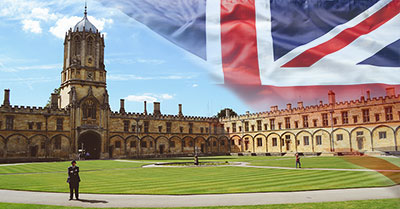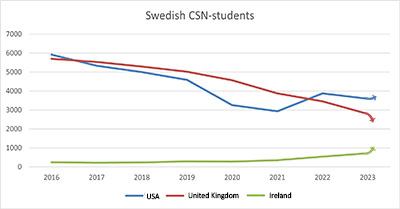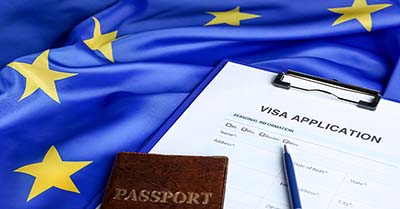Study in Scandinavia
Do you want to study in Sweden, Finland, Denmark or Norway? Here you will find information about Scandinavian universities, costs, application, visas, scholarships and how we can help.
We are study abroad experts based in Stockholm, Sweden. I have studied at Stockholm University myself and in this article, we will try to answer all common questions that foreign students might have about studying abroad in the Nordic countries.
Table of contents
High ranking universities in Scandinavia
How much does it cost to study in Scandinavia?
Student visa to Sweden, Finland, Denmark, and Norway
Working as an international student in Scandinavi
Scholarships for studying in Scandinavia
Insurance when you study abroad in Scandinavia
Help to apply to Scandinavian universities
What is Scandinavia?
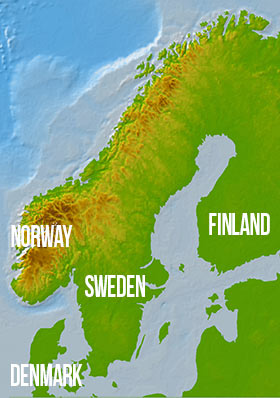
The title of this article is Study in Scandinavia. So what does Scandinavia mean? Locally the term Scandinavia refers to the three kingdoms of Norway, Sweden, and Denmark. The Scands is the name of the mountain range that runs through all of Norway and the western part of Sweden. Those two countries also make up the Scandinavian peninsula, and before the last ice age, Denmark also belonged to the peninsula. If you look at the map you can see that the tip of Denmark would fit snuggly between Sweden and Norway.
Another connection between these three countries is mutually intelligible languages. Swedish is also spoken in part of Finland, and in English Finland is often included in the term Scandinavia. This is the definition that we will use in this article. But we will not include the smaller Nordic countries of Iceland and the Faroe Islands, few international students study there.
Why study in Scandinavia
There are many reasons to study in Scandinavia. These countries are usually all ranked top 10 in the world for happiness and quality of life. They are very liberal countries where democracy, peace, and freedom of speech are highly valued. They have a strong social safety net offering free education and free healthcare for their citizens and for other EU citizens as well. Sweden has a strong tradition of being open to foreigners and together with the other Scandinavian countries they have been a leading country for LGBT-rights.
In Scandinavia, you are always close to nature, even in the big cities. Forests and lakes are never far away, and Scandinavia also offers some spectacular mountain and ocean scenery. The winter is perfect for skiing and in summer hiking and water sports are popular activities. The countries are sparsely populated so you will never feel overcrowded in Scandinavia.
Together with the dutch, the Scandinavians are the best non-native speakers of English in the world. It is very easy to get by in English since almost everyone has a good command of the language. Learning the local languages is not necessary unless you plan to settle. Swedish, Danish and Norwegian are Germanic languages that are relatively easy to pick up if you speak German, but they are also related to English. Finnish on the other hand is a quite challenging language to learn, even for other Scandinavians.
But no place is perfect. Living costs are high in Scandinavia, with Norway being the worst in that regard. Winters are long and dark, not least in northern Scandinavia, and summer is relatively short. The majority of university programs are taught in the local languages, especially on undergraduate level, so all programs will not be available in English.
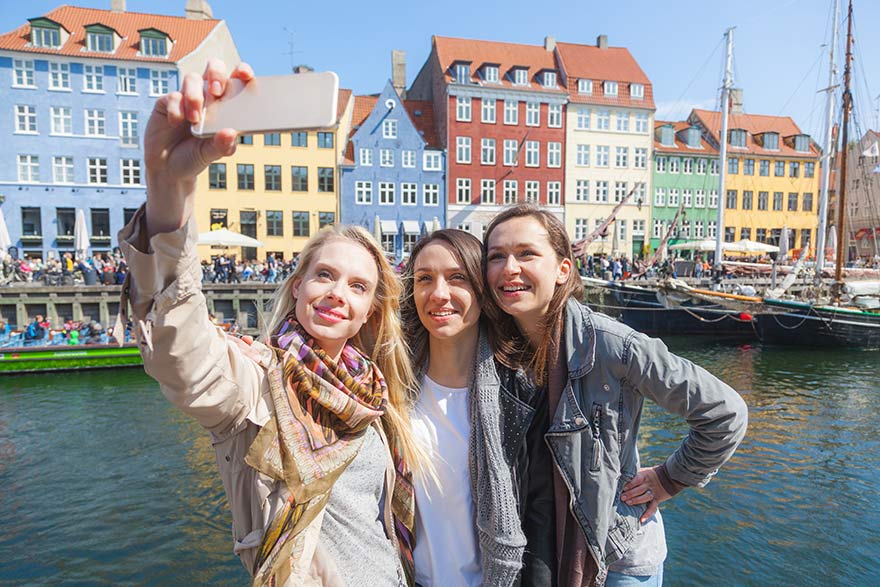
School system
The Scandinavian countries have similar school systems where students usually start pre school when they are 6 years old. Thereafter follows nine years of compulsory school followed by three years of voluntary Upper secondary school where students can choose a specialisation such as business, technology or vocational programs. The majority of Scandinavian students complete Secondary School.
To continue to university in Scandinavia a student must have graduated from Secondary School. Undergraduate programs in Scandinavia and EU countries last for three years and encompass 180 ECTS credits. One years studies (usually 40 weeks) is equivalent to 60 ECTS-credits. Two ECTS credits equals one American university credit.
The school year usually consists of two semesters:
- Fall semester: from late August to December (most programs start in the fall)
- Spring semester: January to the beginning of June
Scandinavian students are not as degree focuses as other nationalities. Students of all ages attend university to study subjects they are interested in and subjects that can help them in their career, but unless they take a fixed program like engineering or medicine, a degree is not always the ultimate goal. It is also more common for Scandinavian students to put off going to university to work and take a gap year first.
International students in Scandinavia take Study Abroad-semesters on undergraduate level or Master programs taught in English. Most undergraduate degree programs are taught in the local languages, but it is possible to take a full Bachelor’s Degree in English at some universities, not least in Finland.
High ranking universities in Scandinavia
Another reason to study in Scandinavia is the quality of the universities. Scandinavia has many good universities and they are strong in subjects such as IT, technology and medicine. Here we list the highest-ranking Scandinavian universities according to the Times Higher Education World University Rankings:
- 41 Karolinska Institutet, Sweden
- 96 Lund University, Sweden
- 96 University of Helsinki, Finland
- 101 University of Copenhagen, Denmark
- 102 Uppsala University, Sweden
- 115 Aarhus University, Denmark
- 131 University of Oslo, Norway
- 175 Stockholm University, Sweden
- 184 Aalto University, Finland
- 184 Technical University of Denmark
- 186 University of Gothenburg, Sweden
- 201-250 KTH Royal Institute of Technology, Sweden
- 201-250 University of Oulu, Finland
- 201-250 University of Bergen, Norway
- 201-250 Aalborg University, Denmark
- 201-250 Copenhagen Business School, Denmark
- 251-300 Chalmers University of Technology, Sweden
- 251-300 Tampere University, Finland
- 251-300 University of Southern Denmark
This ranking does not even include high ranking niche schools such as Stockholm School of Economics a world class business school highly ranked by Financial Times. For a complete list of universities see our country pages for Sweden, Finland, Norway and Denmark.
When and how to apply?
The application deadline for the fall semester (when most programs start) is usually in January for international students. The application deadline for the spring semester is in August. Some institutions organize supplementary application rounds for late applicants.
Most international students in Scandinavia attend programs taught in English. You will need to prove that your English is good enough. Usually, IELTS Academic 6.5 (with no section below 5.5) or TOEFL IBT 90 or higher is required by Scandinavian universities.
To apply for an undergraduate level program you must usually have completed Secondary school and studied for at least 12 years. Undergraduate programs in subjects such as medicine, engineering, or natural science often require a high level in subjects such as Mathematics, Physics, Chemistry or Biology. American students must have successfully taken Advanced Placement (AP) tests or equivalent in these subjects.
We have a partner who can help students from the Americas and Oceania to apply to selected universities in Scandinavia free of charge. Fill out our info request form to get help!
For students of other nationalities, we refer to the official guidelines issued by each country, listed below.
How to apply to study in:

How much does it cost to study in Scandinavia?
Studying in Scandinavian universities is free for students from EU/EEA countries. The only exception is a handful of private colleges like BI Norwegian Business School.
Tuition used to be free for other nationalities in Scandinavia as well, but the burden on the system became too big with the influx of many international students choosing Scandinavia primarily for their free education. Therefore Sweden, Denmark, and many universities in Finland now charge tuition fees for international students. Public Norwegian universities are still free for international students. The challenge is that most programs are taught in Norwegian and programs in English can be highly competitive and living costs are significantly higher in Norway than in the other Scandinavian countries.
Tuition fees vary between different schools and subjects. Social science and humanities usually have the lowest fees, with a tuition fee in Sweden of about $8000-$11000 USD per year (ten times that amount in SEK) with current exchange rates. Technical programs and natural sciences cost about $12000-$14500/year and architecture and design programs cost $19000-$27000/year.
Living costs in Scandinavia are higher than in many other countries. The University of Bergen estimates living costs for students in Norway to 12122 NOK (close to $1200) per month while Study in Sweden suggests 8370 SEK (about $840) per month for studying in Sweden. In Finland and Denmark costs are similar to Sweden. But costs vary a lot based on your accommodation and habits. In the capital cities, you should budget for a bit more while smaller locations can provide lower costs of living.
Student visa to Sweden, Finland, Denmark, and Norway
Students from EU/EEA countries do not need a visa to study in Scandinavia, but if you will stay for longer than three months (or one year in Sweden) you need to register with local authorities.
Non-EU students must apply for an EU-student visa before arriving in Scandinavia. The only exception is short term students (less than three months) from countries with visa waiver agreements with your chosen country of study.
To apply for a student visa/student residence permit to the Scandinavian countries follow these steps:
- Apply to a Scandinavian university and receive your acceptance letter
- Pay your first tuition fee instalment
- Fill out the visa application with supporting documents. The needed documents are usually:
- A passport copy
- Notice of admission to your university
- Health insurance documents
- Account statement and/or other documents (like scholarships) showing that you have the means to support yourself. In Finland, in 2020 you need to show 560 Euro per month for living costs and in Sweden, $850 (8514 SEK) is required/month. Norway currently asks for $11650 (121220 NOK) per academic year, while Denmark asks for around 1000 Euro/month.
- Pay the application fee
- After your application has been processed you usually need to visit the Embassy or consulate of your country of study
- Thereafter you will receive your visa/student residence permit
Read more about student visa to:
Working as an international student in Scandinavia
EU students can work without restrictions in Scandinavia. To work you will need a personal identity number that you can get from the tax authorities. Please be aware that it is not always easy to find jobs for international students in Scandinavia.
Non-EU students are allowed to work part-time if they have a student residence permit (student visa). Sweden has no limit on how many hours you are allowed to work, but you must keep up with your studies in order to keep your visa status so you cannot do more than a part-time job. In Norway and Denmark international students can work at the most 20 hours per week and in Finland 25 hours per week. If you stay in the country over the summer holidays you are allowed to work full time in Denmark and Finland.
Scholarships for studying in Scandinavia
Native students in Scandinavia have free tuition and access to student grants and loans from their governments. Therefore scholarships has not been as common here as in many other countries. However, with the introduction of tuition fees for international students the Scandinavia countries have also started to offer more scholarships for international students who are passionate about studying here.
Read more about the official scholarships for studying in:
You can find more information in our scholarship guide for studying abroad.
Insurance when you study abroad in Scandinavia
To get a student visa to study in Scandinavia you must show proof of a study abroad insurance. EU citizens with the EU-card can get healthcare in Scandinavia on the same conditions as the natives. However we still strongly suggest you get student insurance. Good insurance does not only cover basic healthcare but also accidents, theft, liability, legal costs, and much else.
For studying in Scandinavia we primarily recommend AVI’s Security Passport insurance that is available for all nationalities.
Help to apply to Scandinavian universities
We can help students from all over the world to study at IBA International Business Academy in Denmark and we have a partner who can help non EU-students to apply to selected Scandinavian universities. They will help you free of charge with choosing and applying to a school, getting a student visa, and other questions you have about studying in Scandinavia, but you need your own funding for tuition fees and living costs. Fill out an info request to get help!
Please note that we cannot help EU students to study in Scandinavia, but you can find a lot of useful information on the links in this article, and you can download our study abroad handbook for a step by step guide on how to study abroad.

